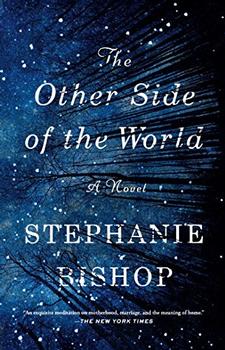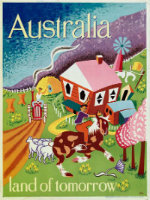Summary | Excerpt | Reading Guide | Reviews | Beyond the Book | Read-Alikes | Genres & Themes | Author Bio

Critics' Opinion:
Readers' Opinion:
First Published:
Sep 2016, 256 pages
Paperback:
Jun 2017, 256 pages
 Book Reviewed by:
Book Reviewed by:
Rebecca Foster
Buy This Book
This article relates to The Other Side of the World
Author Stephanie Bishop's maternal grandparents left England for Australia in 1965. Her grandmother was reluctant to make the move and never truly warmed to the country. Their experience forms the basis of The Other Side of the World. (Bishop's Guardian article gives the whole story.)
Beginning in the latter decades of the eighteenth century, Australia was the destination of boatloads of British criminals. This influx of free convict labor handily coincided with Britain's colonization of Australia, beginning with its east coast. (For more details, see the Beyond the Book article for Kate Grenville's The Lieutenant.) The 1940s through early 1960s also saw a huge increase in immigration to Australia. In part this was because the country was still reeling from World War II and its government felt that a larger population base would protect against potential future invasions – the strategy was called "Populate or Perish."
 To that end, the country introduced the Assisted Passage Migration Scheme in 1945. British migrants to Australia and New Zealand were nicknamed "Ten Pound Poms" or "Ten Pound Tourists" because the subsidized fare for an adult migrant was just £10, and children traveled for free. Over one million British citizens took advantage of the scheme, which ran well into the 1970s. Migrants were required to stay for at least two years; if they did not, they had to refund the full cost of their passage.
To that end, the country introduced the Assisted Passage Migration Scheme in 1945. British migrants to Australia and New Zealand were nicknamed "Ten Pound Poms" or "Ten Pound Tourists" because the subsidized fare for an adult migrant was just £10, and children traveled for free. Over one million British citizens took advantage of the scheme, which ran well into the 1970s. Migrants were required to stay for at least two years; if they did not, they had to refund the full cost of their passage.
However, at the same time up to 12,000 war refugees from Eastern Europe were descending on Australia per year. There was, then, a racial element to the Ten Pound Poms campaign, though it was unspoken; the idea was to keep Australia British by filling it with "British stock" and reinforcing the "British way of life." As Arthur Calwell of the Department of Immigration put it, "It is my hope that for every foreign migrant there will be 10 people from the United Kingdom." This may explain why Henry Blackwood, the Anglo-Indian character in The Other Side of the World, struggles with institutional racism after his arrival in Australia.
Gradually Australia started relaxing its policies to allow non-Europeans to take up citizenship. For instance, after a required dictation test was abolished, immigration from the Middle East increased. Unrest in the 1970s and 1980s – the fall of Saigon and the Tiananmen Square massacre – also led to an increase in settlement from Asia. In the 1990s the rules tightened up again to prevent "boat people" from finding domicile, and in 2007 a ban was placed on refugees from Africa to stem the tide of immigrants from Sudan.
In 2016 matters took an uglier turn. Amnesty International reported that 1,200 would-be refugees (many from the Middle East and the Indian subcontinent) who arrived to Australia by boat had been turned away by force and detained on the Pacific island of Nauru. Australia and Nauru formed Memorandums of Understanding in 2012 that have allowed asylum seekers to be exiled on Nauru for, in some cases, up to three years. In interviews refugees described the Nauru facilities as prison-like and reported that they do not have access to adequate health care. A similar crisis unfolded in Papua New Guinea's Manus Island.
Today the easiest routes of immigration to Australia are employment visas for certain highly skilled workers, a family visa on the basis of ancestral ties, or a student visa. The Australian government website offers specific advice on these different options and more.
Picture of Australian government poster from National Archives of Australia
Filed under Society and Politics
![]() This "beyond the book article" relates to The Other Side of the World. It originally ran in October 2016 and has been updated for the
June 2017 paperback edition.
Go to magazine.
This "beyond the book article" relates to The Other Side of the World. It originally ran in October 2016 and has been updated for the
June 2017 paperback edition.
Go to magazine.





The Flower Sisters
by Michelle Collins Anderson
From the new Fannie Flagg of the Ozarks, a richly-woven story of family, forgiveness, and reinvention.

The House on Biscayne Bay
by Chanel Cleeton
As death stalks a gothic mansion in Miami, the lives of two women intertwine as the past and present collide.

The Funeral Cryer by Wenyan Lu
Debut novelist Wenyan Lu brings us this witty yet profound story about one woman's midlife reawakening in contemporary rural China.
Your guide toexceptional books
BookBrowse seeks out and recommends the best in contemporary fiction and nonfiction—books that not only engage and entertain but also deepen our understanding of ourselves and the world around us.